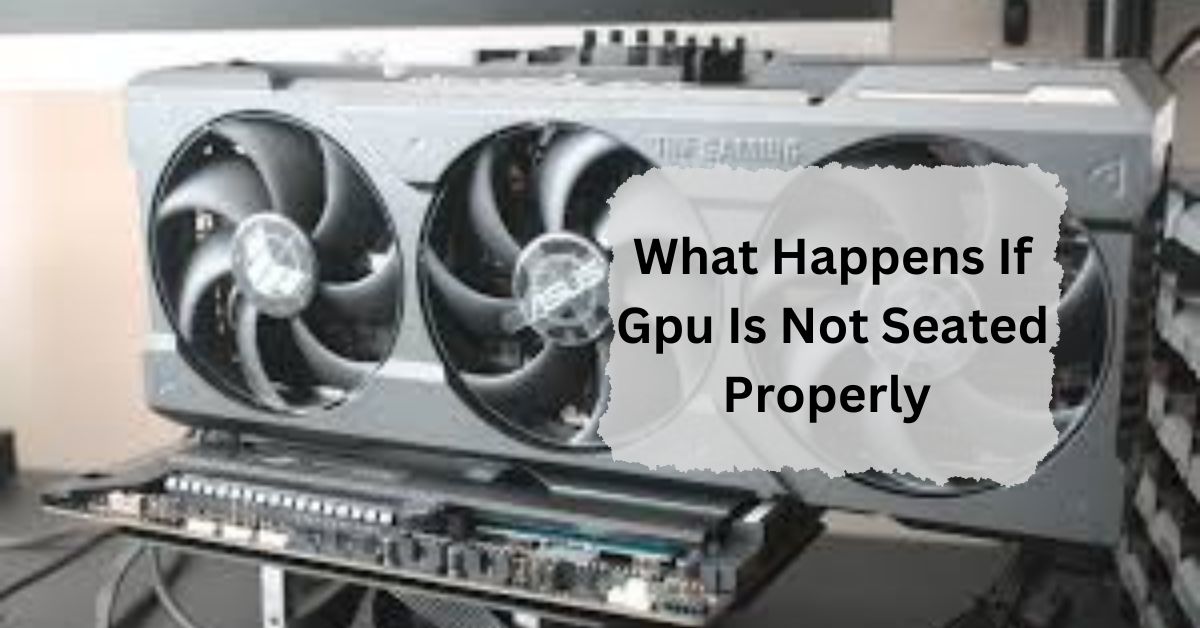When building or upgrading a PC, ensuring your GPU (Graphics Processing Unit) is properly seated is a step that should not be overlooked. The GPU is the powerhouse behind rendering graphics, running games, and handling video-intensive tasks.
If a GPU is not seated properly, your computer might not display anything on the screen, may crash, or fail to boot. It can also cause overheating, strange noises, or poor performance.
In this article, we will discuss “What Happens If Gpu Is Not Seated Properly”.
Table of Contents
Why Proper Gpu Seating Is Crucial?
The GPU plays a vital role in the overall performance of your computer. It handles the graphical output, making it essential for gaming, video editing, and other graphics-intensive tasks.
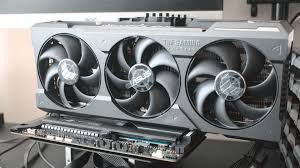
A properly seated GPU ensures that the connections between the GPU and the motherboard are secure, enabling optimal data transfer and power supply. Without a proper connection, the GPU cannot function correctly, leading to various system problems.
Signs That Your Gpu Is Not Seated Properly:
1. No Display On Monitor:
One of the most common signs of an improperly seated GPU is a blank monitor. If your screen remains dark after powering on the computer, it’s a clear indication that the GPU might not be connected properly.
2. Computer Fails To Boot:
An incorrectly seated GPU can prevent your computer from booting up. The system may start, but you’ll hear beeps or see error codes indicating that the GPU is not recognized.
3. Intermittent Display Issues:
If your GPU is not seated correctly, you might experience flickering screens, random blackouts, or other display anomalies. These issues often occur due to an unstable connection.
4. Error Messages Related To Gpu:
Your operating system may show error messages related to the GPU, such as driver errors or hardware not detected warnings. These messages are a strong sign that the GPU is not properly seated.
5. System Crashes Or Freezes:
If your computer crashes or freezes during use, an improperly seated GPU could be the culprit. The unstable connection can lead to system instability, causing frequent crashes.
How To Check If Your Gpu Is Properly Seated?
To ensure your GPU is seated correctly, follow these steps:
- Power Down Your Computer: Always turn off your computer and unplug it from the power source before handling any internal components.
- Open the Case: Remove the side panel of your computer case to access the internal components.
- Inspect the GPU: Look at the GPU and its connection to the PCIe slot. Ensure the card is aligned correctly and fully inserted into the slot.
- Check the Retention Clip: The PCIe slot often has a retention clip that locks the GPU in place. Make sure this clip is engaged.
- Verify Power Connections: Ensure that the GPU’s power connectors are properly attached. Some GPUs require additional power from the PSU (Power Supply Unit).
Common Mistakes When Installing A Gpu:
1. Not Aligning The Gpu Correctly:
The most common mistake is not aligning the GPU correctly with the PCIe slot. Even a slight misalignment can prevent proper seating.
2. Forgetting To Screw Down The Gpu:
Securing the GPU with screws is crucial to keeping it in place. Without screws, the card may become loose over time.
3. Loose Pcie Connections:
The PCIe connection must be tight and secure. A loose connection can cause various issues, including display problems and system crashes.
4. Not Connecting The Power Supply Correctly:
Some GPUs require extra power connections. Forgetting to attach these can lead to the GPU not functioning at all.
How To Properly Install A Gpu?
1. Step-By-Step Guide To Installing A Gpu:
- Begin by ensuring your computer is powered off and unplugged.
- Open the case and locate the PCIe slot on your motherboard.
- Carefully align the GPU with the slot and gently press it in until the retention clip snaps into place.
2. Ensuring A Secure Fit:
After seating the GPU, secure it with screws to the case to prevent any movement. This step is crucial for maintaining a solid connection.
3. Double-Checking Connections:
Once the GPU is in place, attach any necessary power connectors from the PSU. Double-check all connections before closing the case.
Potential Damage From Improperly Seated Gpu:
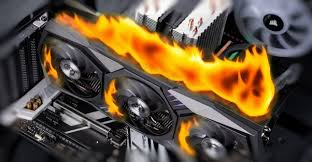
- Risk to the GPU Itself: An improperly seated GPU can suffer from electrical shorts, which may permanently damage the card.
- Motherboard Damage: If the GPU is not seated correctly, it can cause damage to the PCIe slot on the motherboard, leading to costly repairs.
- Risk of Short Circuits: Loose connections can lead to short circuits, posing a risk not only to the GPU but also to other components.
- Impact on Other Components: An improperly seated GPU can cause system instability, potentially damaging other components like the CPU or RAM.
What To Do If Your Gpu Isn’t Working After Installation?
If your GPU isn’t working after installation, try these troubleshooting steps:
- Re-seat the GPU: Remove the GPU and re-seat it, ensuring it is properly aligned and securely connected.
- Check Power Connections: Verify that all power connections are properly attached.
- Update Drivers: Sometimes, the issue may be with outdated or missing drivers. Ensure you have the latest GPU drivers installed.
- Seek Professional Help: If the problem persists, it might be time to consult a professional technician.
What Happens If The Gpu Is Not Seated Properly In Windows?
If the GPU is not seated properly in Windows, the computer may not display anything, fail to boot, or show errors. It can also cause crashes, low performance, or the GPU not being detected.
What Happens If The Gpu Is Not Seated Properly Gaming?
If the GPU is not seated properly while gaming, the game may crash, freeze, or show poor performance. You might also see strange graphics, black screens, or the computer might restart unexpectedly.
How To Know If The Gpu Is Seated Properly?
To know if the GPU is seated properly, check if it clicks into the slot securely. The computer should boot without issues, display correctly, and the GPU should be detected in the system.
Gpu Not Lining Up With Case:
If the GPU is not lining up with the case, it may not be seated correctly in the slot. This can cause connection issues. Re-seat the GPU, ensuring it’s aligned with the case properly.
What Kind Of Damage Can A Gpu Get If It’s Not Seated All The Way Down In The Pci Slot?
If a GPU isn’t seated all the way in the PCI slot, it can cause poor connections, leading to system crashes, overheating, or even permanent damage to the GPU or motherboard over time.
Pcie Not Detecting Graphic Card:
If the PCIe slot is not detecting the graphics card, it might be due to the card not being seated properly, a faulty slot, outdated drivers, or power supply issues. Reseat the card and check connections.
Bizarre Issue With Fitting The Gpu Into The Pcie Slot?
A bizarre issue fitting the GPU into the PCIe slot could be due to misalignment, obstructions, or a warped motherboard. Ensure the slot is clear, the GPU is aligned, and gently press it in place.
How Do You Tell If Your Gpu Is Installed Properly?
To tell if your GPU is installed properly, check if it is firmly seated in the slot, the connections are secure, and your computer boots up without issues. The GPU should be recognized by the system.
What Does Reseating Gpu Do?
Reseating the GPU involves removing and reinserting it into the PCIe slot. This can fix connection issues, ensure a proper fit, and resolve problems like crashes, screen artifacts, or the GPU not being detected.
Is The Gpu Supposed To Click Into Place?
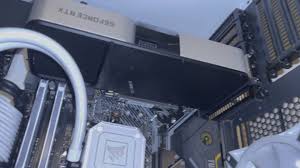
Yes, the GPU should click into place when properly inserted into the PCIe slot. This click indicates that the GPU is securely seated and correctly connected for stable performance.
FAQs:
1. Can A Loosely Seated Gpu Cause Permanent Damage?
Yes, a loosely seated GPU can cause permanent damage. It may lead to overheating, electrical issues, or physical damage to the GPU or motherboard. Properly seating the GPU helps prevent these problems.
2. How Can I Avoid Seating Issues In The Future?
To avoid seating problems in the future, book your seats early, check the seating plan, and confirm your choices. Always review the seating rules and contact customer service if you have special needs.
3. What Tools Do I Need For Gpu Installation?
For GPU installation, you need a screwdriver, thermal paste, anti-static wrist strap, and cleaning cloth. Make sure you have the correct GPU drivers and a power supply that matches the GPU requirements.
4. How Often Should I Check My Gpu Seating?
Check your GPU seating every few months or if you notice computer problems, like freezing or crashing. Regular checks help ensure your GPU is secure and working properly to avoid damage.
5. Can Improper Seating Void My Warranty?
Yes, improper seating can void your warranty. If the GPU is not correctly installed and gets damaged, the manufacturer may not cover repairs or replacements under the warranty terms.
Conclusion:
In conclusion, ensuring your GPU is properly seated is crucial for your computer’s performance and stability. An improperly seated GPU can lead to display issues, crashes, or permanent damage to components. Regular checks and correct installation prevent problems and keep your PC running smoothly.
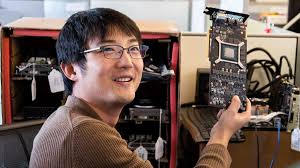
I’m Noah Lucas, the voice behind the content you find here. With 5 years of experience in the GPU field, my goal is to provide clear and helpful information to everyone interested in this technology.
Whether you’re new to GPUs or looking to deepen your understanding, my articles aim to break down complex topics into simple, easy-to-understand language. This way, no matter where you’re from, you can find the information you need without any confusion.

